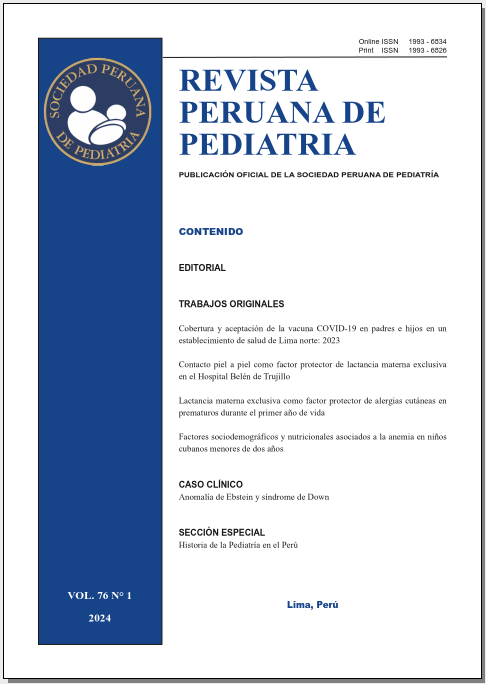Skin-to-skin contact as a protective factor for exclusive breastfeeding at the Belén Hospital in Trujillo
DOI:
https://doi.org/10.61651/rped.2024v76n1p2a1-2a10Keywords:
Skin-to-skin contact, Exclusive BreastfeedingAbstract
Objective: Determine if skin-to-skin contact for 60 minutes is a protective factor for exclusive breastfeeding during the first six months of life of children born at the Belén Hospital in Trujillo.
Materials and methods: Retrospective observational study.
Results: Of the 206 patients who participated in the study, 103 of them enjoyed exclusive breastfeeding until 6 months of age. Within this group, it was observed that 91.3% of newborns, that is, 94 babies, experienced skin-to-skin contact at birth. Of the 103 children who were not exclusively breastfed until 6 months of age, 89 (86.2%) did not experience skin-to-skin contact at birth. With these data, an OR of 79.044 IC 95% 27.372 – 161.062 was calculated, which indicates a strong relationship between exclusive breastfeeding until 6 months of age and skin-to-skin contact at the time of birth. In the group of patients who stopped exclusive breastfeeding before 6 months, abandonment of breastfeeding occurred sequentially in the 1st, 2nd, 3rd, 4th and 5th months, with respective percentages of 23.3%, 19.4%, 26.2%, 19.4% and 11.6%. The most frequent reasons for abandoning breastfeeding were: low breast milk production (34%), work reasons (17%), academic reasons (12%), among others. In the multivariate analysis, it was observed that maternal age, gestational age, weight of the newborn, level of maternal education and origin of the mother did not have a significant effect on the dependent variable.
Conclusions: Skin-to-skin contact for 60 minutes is a protective factor for exclusive breastfeeding until children are 6 months old.
Downloads
Downloads
Published
How to Cite
Issue
Section
Categories
License
Copyright (c) 2024 Eduardo Miñano Adrianzen, Luz Cisneros Infantas

This work is licensed under a Creative Commons Attribution 4.0 International License.
Authors will retain the copyright and grant the right to publish their work in the journal while allowing third parties to share it under the Creative Commons Attribution license.
Articles are published under a Creative Commons license that allows sharing and adaptation with appropriate credit. CC BY 4.0 license. Available in English at https://creativecommons.org/licenses/by/4.0/
Authors may use other information disclosure formats as long as the initial publication in the journal is cited. The dissemination of the work through the Internet is recommended to increase citations and promote academic exchanges.
The published content does not necessarily reflect the specific point of view of the journal, and the authors assume full responsibility for the content of their article.



